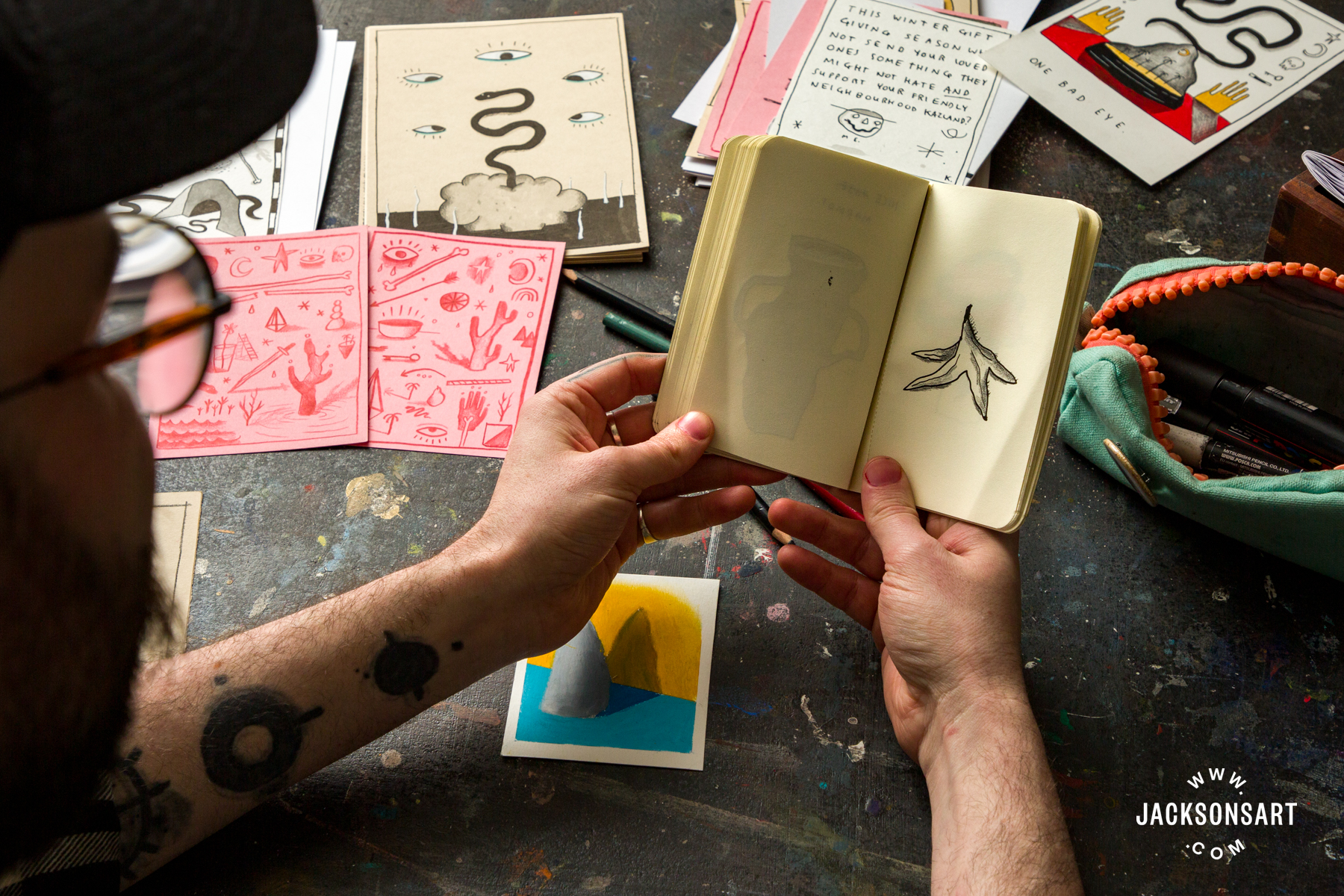Kazland is the art pseudonym of Guildford-based artist Callum Buckland. While his sketchbook practice is different from any of the other artists we’ve featured in our Inside the Sketchbook series so far, it is one that many artists will relate to and use themselves. In a sense, Kazland’s studio walls create the binding of his sketchbook, so his drawings can manifest on a variety of different sized paper surfaces. Kazland visited us in the Jackson’s studio to explain how he keeps track of his ideas with this unbound process.
Kazland Takes Us Through His Sketchbook Practice
For the last four or so years, I’ve stopped using sketchbooks as much and started using pieces of paper that either get taped to my studio wall for quick inspiration when I’m struggling, or put in a box to be found again later. I do still use a book from time to time but the pages more often than not get torn out and added to the wall… I like those really little Daler Rowney pocket sketchbooks with rounded corners. They’re great for keeping in a backpack or an actual pocket for drawing out and about. The really smooth, ivory paper takes ink surprisingly well for thinner paper. Easy to lose though.

I don’t really plan or sketch much of my work beforehand, but I’m a big believer in maintaining a daily drawing practice and it always helps in one way or another. It often takes some outside eyes to point out the links between my paintings and my drawings to me – I find it hard to notice as it’s almost never intentional. That could be why I like to surround myself with little drawings – They can all just be absorbed slowly without really knowing it.


Most of my drawing happens in the morning, just after breakfast. I like to do this every day if I can – I’ll often draw in bed before I fall asleep too, but if it’s not to save an idea I’ve just had, they rarely make the wall.

For as long as I’ve been working I’ve been using the exact same pens – Posca PC-1M and I’m yet to find something I prefer to draw or write with. If the paper has any tooth to it the pens can spit and splutter and I just love it. I like to have a good selection of different tools on me at all times. Other than my favourite pens, I usually have a Stabilo Woody 3in1, some Caran d’Ache Neocolour I and II and I like Prismacolors Premiers and Faber Castell Polychromos Pencils at the minute. There’s also a specific thick black Posca PC-7M I use to draw snakes. It’s all I use them for – it’s perfect. Oh and my latest obsession is with the Caran d’Ache Neopastels. I’m still sort of figuring them out, but they’re so vibrant and just beautiful to work with.


My go-to paper is really anything from a special pile I have of carefully cut-up, abandoned works on paper. It’s a mixture of Fabriano Eco Paper, Daler Rowney Aquafine Watercolour Paper, Bristol Board 300 Series, and any nice scraps I find lying around. I’ve started trying more watercolour work and I’ve been really into the Global Fluid Easy Block Hot Pressed Paper. They’re glued on two edges so they don’t wrinkle or lift up with wet mediums.

Like so many other artists I found that if I have a really nice sketchbook I put off ever using it and save it for something special… A series of immaculate drawings that would never come. And the threat of having to tear out the shameful failed sketches and bad ideas is even greater. The single scrap of paper method has zero pressure, it’s all about just making something, which I really respond well to. And being able to reorder the drawings, take them away, destroy the bad ones, and display the best ones is good for the soul. Probably.

Materials
Posca PC-1M
Posca PC-7M (bullet tip)
Caran d’Ache Neopastels
Caran d’Ache Neocolour I
Caran d’Ache Neocolour II
Prismacolor Premier Pencils
Faber Castell Polychromos Pencils
Stabilo Woody 3in1
Fabriano Eco Paper Pad
Global Fluid Easy Block Hot Pressed Paper
Daler Rowney Ivory Softbound Pocket Sketchbook
Daler Rowney Aquafine Watercolour Paper
Bristol Board 300 Series (all sizes)

About Kazland
Kazland is a self taught, mixed media artist from the south of England. Creating almost entirely through intuition, he makes work that is about telling stories and finding balance with abstract compositions. He creates abstract narratives of familiar shapes and recurring symbols, using different mediums and irresponsibly placed shadows to force perspective and breathe depth into his work. Often working on 2 or 20 paintings at once he jumps between them to bring across palettes and themes, weaving them all together into a cohesive world.
Further Reading
Five Minute Drawing Exercises
How to Use Watercolour Pencils
Inside the Sketchbook of Frances Ives
Developing a Daily Drawing Practice With the Royal Drawing School
Shop Sketchbooks on jacksonsart.com








